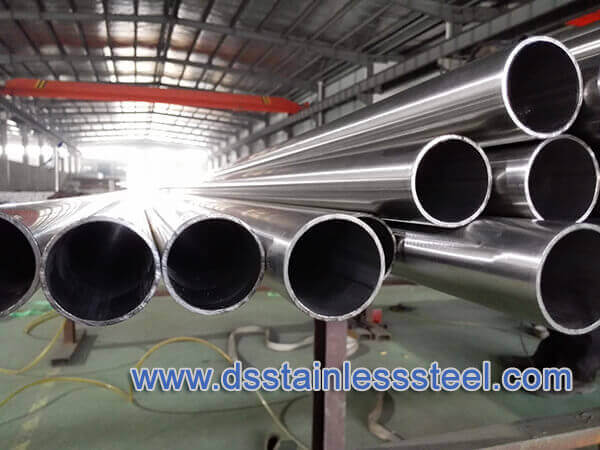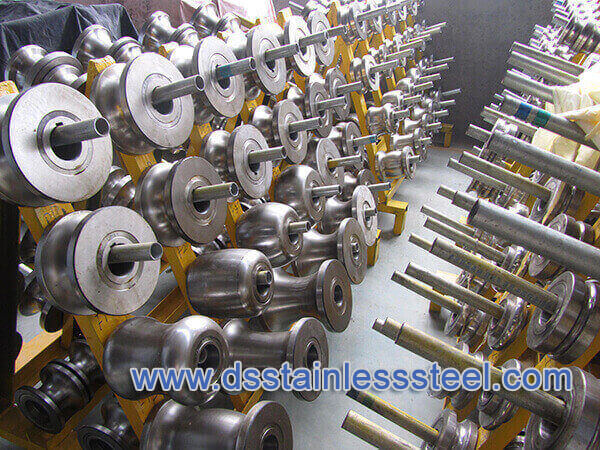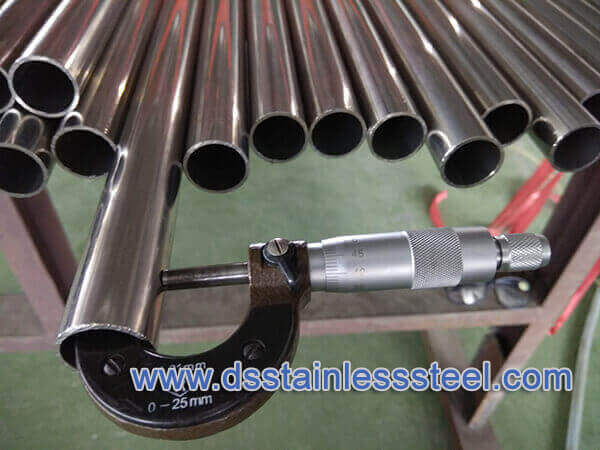Welded Stainless Steel Tube

Welded stainless steel tube is produced in a wide range of sizes and grades for various applications, welded tube is manufactured through roll-forming strips or sheets of stainless steel into a tube shape and then welding the seam longitudinally, welded tubes conform to ASTM A249, A269, A270, A312, A789 and EN specifications, there are many grades for options, these grades include 304/304L, 316/316L, 321 and duplex steel grades.
Welded Tubes can be finished in as welded, welded and drawn, polished, and bright annealed conditions, our tubes are strictly in accordance with ASTM and international standards, and all the tubes are conducted by non-destructive testing and destructive testing, these tests include eddy current and ultrasonic and pressure testing, professional manufacturing and tests are to ensure consistent weld and high quality.
Welded Stainless Steel Tube Specifications
| Specifications | Tube/Pipe Type | Material | Applications |
|---|---|---|---|
| ASTM A249 | Welded | Austenitic Steel | Boiler, Superheater, Heat Exchanger, And Condenser |
| ASTM A268 | Seamless And Welded | Ferritic And Martensitic Stainless Steel | General Service |
| ASTM A269 | Seamless And Welded | Austenitic Stainless Steel | General Service |
| ASTM A270 | Seamless And Welded | Austenitic And Ferritic / Austenitic Stainless Steel | Sanitary Tubing |
| ASTM A312 | Seamless, Welded, And Heavily Cold Worked | Austenitic Stainless Steel | High-Temperature And General Corrosive Service |
| ASTM A358 | Welded | Austenitic Chromium-Nickel Stainless Steel | High-Temperature Service And General Applications |
| ASTM A554 | Welded | Stainless Steel | Mechanical Tubing |
| ASTM A688 | Seamless And Welded | Austenitic Stainless Steel | Feedwater Heater |
| ASTM A789 | Seamless And Welded | Ferritic/Austenitic Stainless Steel | General Service |
| ASTM A790 | Seamless And Welded | Ferritic/Austenitic Stainless Steel | General Service |
| EN 10217-7 | Welded | Stainless Steel | Pressure And Corrosion Purpose |
| EN 10312 | Welded | Stainless Steel | Water And Other Liquids |
Stainless Steel Grades
There are several types of stainless steel, Austenitic Stainless Steel, Martensitic Stainless Steel, Ferritic Stainless Steel and Duplex Stainless Steel, each type has a base grade and numerous variations, each grade has unique physical and chemical properties, and selecting the right stainless steel grade depends on the specific application.
AISI/ASTM Grades
300 series: 304, 304L, 309/309s, 310/310S, 316, 316L, 316Ti, 317L, 321
400 series: 409, 409L, 410, 420, 430, 431, 439, 440, 441, 444
Duplex stainless steel: S32750, S32760, S31803, S32205, S32304
Special Grades: 904L, 347/347H, 254SMo
EN Steel No.
1.4301, 1.4306, 1.4315, 1.4303, 1.4833, 1.4845, 1.4401, 1.4571, 1.4404, 1.4429, 1.4438, 1.4541, 1.4550, 1.4477, 1.4462, 1.4002, 1.4512, 1.4016, 1.4113, 1.4509, 1.4521, 1.4006, 1.4021, 1.4028
Welded Tube Sizes

We have a large variety of rollers, allowing us to manufacture tight tolerance tubing in a wide range of OD and wall thickness dimensions, and in a variety of shapes including round, square, rectangular and oval.
- BWG Gauge Chart
- Fractional, Metric, and Imperial Sizes
- Pipe Schedule Chart, Pipe Size Chart, NPS Pipe Diameter
- Stainless Steel Tube Weight
- Stainless Steel Tubing Sizes
Welded Tube Processing

- Bright annealed
- Pickling
- Outer surface brushing
- Inner and outer surface polishing
- Inner and outer surface mirror polishing
- Bead rolling or weld seam removing
- Customer defined tolerances
- Cut to length
- U bend welded tubes
- Tubes individually sleeved
- Welded coil tubing
Applications of Stainless Steel Tubing
Heat Exchanger, Boiler, Condenser
- ASTM A249 stainless steel tube, covering Welded Austenitic Steel Boiler, Superheater, Heat-Exchanger, and Condenser Tubes, the tubing sizes and thicknesses usually furnished to this specification are 1/8 in. [3.2 mm] in inside diameter to 12 in. [304.8 mm] in outside diameter and 0.015 to 0.320 in. [0.4 to 8.1 mm], inclusive, in wall thickness.
- ASTM A269 stainless steel tubing, covering Seamless and Welded Austenitic Stainless Steel Tubing for General Service, the tubing sizes and thicknesses usually furnished to this specification are 1/4 in. [6.4 mm] in inside diameter and larger and 0.020 in. [0.51 mm] in nominal wall-thickness and heavier.
- ASTM A268 stainless steel tubing, covering standard specification for a number of grades of nominal-wall-thickness, welded ferritic and martensitic stainless steel tubing for general corrosion-resisting and high-temperature service.
- ASTM A789 stainless steel tubing, covering standard requirements for grades of nominal wall thickness, and stainless steel tubing for services requiring general corrosion resistance, with particular emphasis on resistance to stress corrosion cracking. These steels are susceptible to embrittlement if used for prolonged periods at elevated temperatures.
Mechanical Purpose
- ASTM A554 stainless steel tubing, covering welded austenitic, ferritic, and austenitic-ferritic duplex stainless steel mechanical tubing intended for use in ornamental, structural, exhaust, and other applications where appearance, mechanical properties, or corrosion resistance is needed. As-welded or cold-reduced mechanical tubing in sizes to 16 in. (406.4 mm) outside dimension, and in wall thicknesses 0.020 in. (0.51 mm) and over.
- EN 10296-2, Welded circular steel tubes for mechanical and general engineering purposes
Sanitary Tubing
- ASTM A270 stainless steel sanitary tubing, covering grades of seamless, welded, and heavily cold-worked austenitic and ferritic/austenitic stainless steel sanitary tubing, tubes in sizes up to and including 12 in. [300 mm] in outside diameter.
- EN 10357 Austenitic, austenitic-ferritic and ferritic longitudinally welded stainless steel tubes for the food and chemical industry.
Welded Tubes Quality Control
In all stages from raw material to finished products, tube is manufactured under strict quality control, making sure tube has stable mechanical properties, excellent surface finish and high dimensional accuracy. Specialty testing services can also be provided.
Standard Testing
- Tensile Strength test
- Flattening test
- Flare test
- Flange test
- Dimensional inspection
- PMI
- Hardness test
- Eddy Current test
Optional Testing
- Ultrasonic test
- Hydrostatic test
- Air Under Water test
- Grain Size
- Corrosion test
- Metallographic
- Radiographic test
Welding Methods
Welded stainless steel tube is made from long strip or sheet, passed a rolling machine, then the strip edges are welded longitudinally and melted together, using various welding processes, making the welding beam as same as the base metal, and form into a tube shape.
The sheet width is the desired tube outside diameter, the width should be calculated before manufacturing.
Popular tube and pipe manufacturing techniques are described below.
TIG
Tungsten Inert Gas welding, another name for Gas tungsten arc welding (GTAW), is an arc welding process that uses a non-consumable tungsten electrode to produce the weld. The weld area and electrode is protected from oxidation or other atmospheric contamination by an inert shielding gas.
EFW
Electric Fusion Welding,
ERW
Electric Resistance Welding, high-frequency electrical current is passed between the material edges, then the edges are forced together under pressure as a butt joint and then welded by heating the material to high temperatures.
DSAW
Double Submerged arc welded, similar to other pipe manufacturing processes, the manufacture of Double Submerged Arc Welded Pipe involves first forming steel plates into cylindrical shapes. The edges of the rolled plate are formed so that V-shaped grooves are formed on the interior and exterior surfaces at the location of the seam. The pipe seam is then welded by a single pass of an arc welder on the interior and exterior surfaces.
LSAW
Longitudinal Submerge-arc Welded
HFW
High Frequency Welding,
Heat treatment is generally required after manufacture, this process improves stainless steel welded tube properties and helps welded tubes suitable for wide applications.
Welded Tube VS Seamless Tube
There are differences between welded tube and seamless tube in manufacturing, The typical appearance is that welded have welding seams, without or with additional filler metal, but seamless tube do not.
Size Range
Welded tube can be produced in a wide range of sizes and dimensions, both large diameter and small diameter, it is hard to produce very large size and very thin wall seamless tube.
Production Time
Welded tubes have a short production time, because they possess more simpler manufacturing process, in most conditions, for seamless tube, several producing processes are needed to duplicate, such as cold rolling, and heat treatment.
Working Pressures
The working pressures of the welded tube are approximately 20% less than the seamless tube, the seamless tube is a better selection for use in harsh environments.
Production Cost
Welded tube is an effective cost choice for many applications, seamless tube has a higher price, but it is also durable.
Tolerance
Welded tubes have excellent concentricity, and tight tolerance in outside diameter and wall thickness.
